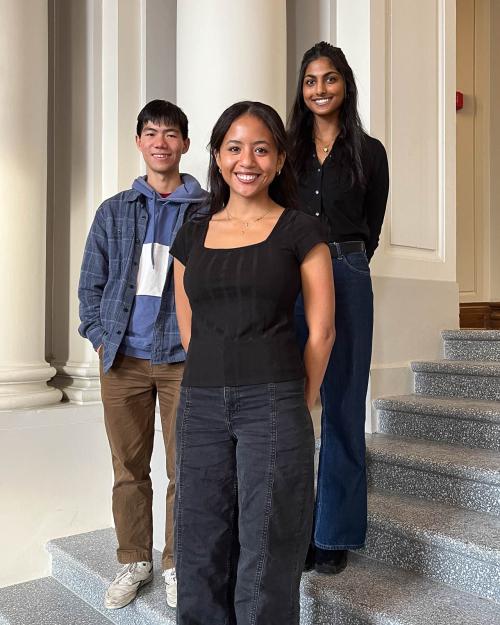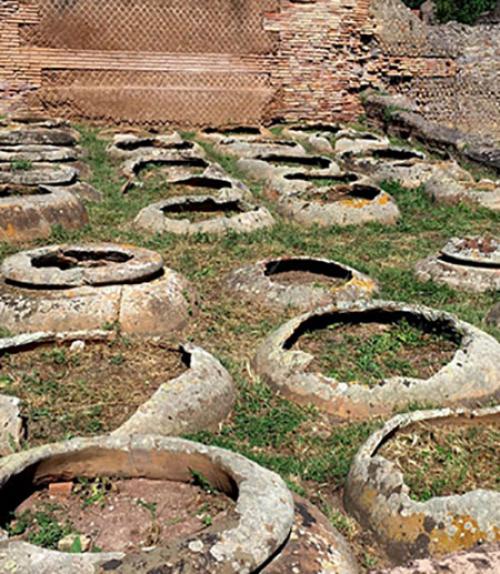“In a complete stranger’s house, I could probably find a toothbrush pretty easily,” says Astrid Van Oyen, Classics. “The spatial specificity in our houses tends to be echoed by the material objects we store in that space.” Dishes go in a kitchen cabinet, pajamas in a bedroom dresser. “In Roman houses, in the time of the Roman Empire, that wasn’t the case,” she explains. “It would be a nightmare for any modern-day organizer.”
Van Oyen is a classical archaeologist who asks questions like an anthropologist. The two disciplines are more closely linked in her native Belgium, where archaeology encompasses all study of human beings through things. “The data I work with is stuff,” she says.
Civil wars racked the Roman Republic during the first century BCE. When the dust settled, the Roman senate vested broad powers in the military leader Octavian, who assumed the title of Augustus Caesar. Van Oyen’s most recent book, The Socio-Economics of Roman Storage (Cambridge University Press 2020), covers Rome’s tumultuous transition from republic to empire and the subsequent years as the empire took shape.
From Warehouses to Cupboards
During the early years of empire, an observer, standing on the docks among the warehouses at the ports of Rome, would see plenty of evidence of a society and economy in flux. In summer, ships unloaded grain from Egypt. Wines and other merchandise arrived from around the Mediterranean Sea. The Italian peninsula could no longer feed Rome, nor sate its appetites.
“Archaeologists and anthropologists have traditionally given storage a crucial role in the formation of empire,” says Van Oyen. “The idea is that as sociopolitical formations scale up—from bands to tribes to chiefdoms to states to empires—they need to bridge spatial and temporal lags. The grain harvest is only once a year, and Rome had an urban population of one million. They somehow had to make sure that the grain that’s harvested now will still be available five months from now.” She adds, “Elites soon start to appropriate storage and storage facilities. Storage becomes a source of power.”
But this standard narrative, according to Van Oyen, tells only part of the story. “It treats everything that gets stored as this abstract thing—surplus. In the book, I’m saying that it matters a great deal what the surplus is made of. Grain rots, wine ferments. Storage brings those differences into focus. The economic behaviors associated with storing wine—and the social relations spurred by it—are totally different from those linked to storing grain.”
“Rome had an urban population of one million. They somehow had to make sure that the grain that’s harvested now will still be available five months from now.”
Like an observer at the ports of Rome, Van Oyen surveys the economics of empire on a grand scale. But she also sifts through household minutiae.
“Usually when archaeologists and anthropologists talk about storage, it’s in the context of agriculture,” says Van Oyen. “They don’t talk about kitchen cupboards and what people kept in their houses.” The Vesuvian towns of Pompeii and Herculaneum were preserved for centuries under volcanic debris, and thanks to old excavations and archival research of the past decades, it’s as if she can peek into cupboards and open chests to look at Romans’ disorganized mishmash of stuff.
Combining Data Sets
Van Oyen examines storage practices to understand how sociopolitical forms emerge and evolve—the different ways that states and empires, for example, organize and distribute power. “I get really frustrated with theoretical interventions that are not grounded in data,” says Van Oyen. “I always want some concrete historical problem or case to advance these debates.”
Van Oyen insists on hard empirical evidence, but her real interest is relationships: enslaved people and their masters, women and men, structures of power and opportunities for resistance in the hierarchical slave society that was ancient Rome. From the stuff that Romans stored, and how they stored it, she fashions a telescopic lens for looking across interconnected scales of power: Roman households and the dynamics of gender and slavery at work there; the economic risks and opportunities that the new empire created for large-scale estate holders; and finally the business dealings of the Roman emperor and his family.
“I wanted to use storage as a way to think jointly about registers and data sets that aren’t usually combined,” she says.
Storage, Memory, and Power
Where you store your toothbrush says what about power? In homes today, things in a room often signal the kinds of activities that happen there. By the same turn, the function of a space continuously reminds us where to look for something. But storage in wealthy Roman households was far less standardized. Things moved in and out of storage often as rooms changed function, sometimes on a seasonal or even daily basis. Ad hoc dividers in a wooden chest would turn one container into many, with each partition holding unrelated items. Smaller containers have often been found nested within larger ones.
“These storage practices challenged centralized control,” says Van Oyen. Instead of relying on spaces to remind them where things were kept, Romans had to rely on the memory of people who lived and labored in a home. No one person could have known where everything was stored, creating opportunities to hide or repurpose objects, giving them new uses and meanings. It’s a style of storage ripe for defiance and subversion. “I found these same dynamics playing out on a larger scale, too,” says Van Oyen, “in warehouses, business dealings, and relationships between members of the imperial family.”
Archaeologists and anthropologists have sometimes theorized that an empire can be thought of like a pyramid, with each level of the hierarchy overseeing the ones below. In this model, administering a vast empire requires a degree of standardization—such as a shared written language and standards of weight and measure—to facilitate top-down control. “In the case of the Roman Empire, the pyramid is not a good model,” says Van Oyen. “The top couldn’t see through to the bottom. It’s a much more complicated, messy system.”
The Ancient Roman Countryside
Van Oyen has codirected the Marzuolo dig in northern Italy, along with colleagues at the University of Arkansas and University of Melbourne, since 2016. “When the excavation began, everyone expected it to be a peasant village,” she says. “Instead we found a lot of evidence of craft production. It’s a type of site that has seen little thorough archaeological investigation. Some people lived there, but the place was focused on exchange and production. The project is adding a missing part to the data set we have of the Roman countryside.”
Van Oyen laughs when asked if findings from the Marzuolo site inform her latest book. “Students are always so surprised when they join me in the field in the summer,” she says. “You have to move a lot of soil and write a lot of notes for every piece of data. For The Socio-Economics of Roman Storage, I needed large data sets to be able to compare and contrast. Each chapter looks at a phenomenon and compares what’s happening at different sites and different regions. The book owes a great deal to the labor of all the archaeologists who, over the course of many decades, excavated and documented all this stuff. At Marzuolo, we explore different kinds of questions, shifting focus away from Roman archaeology’s fetish with cities and elite residences. It’s adding to the archaeological data set. But it’s slow moving.”




